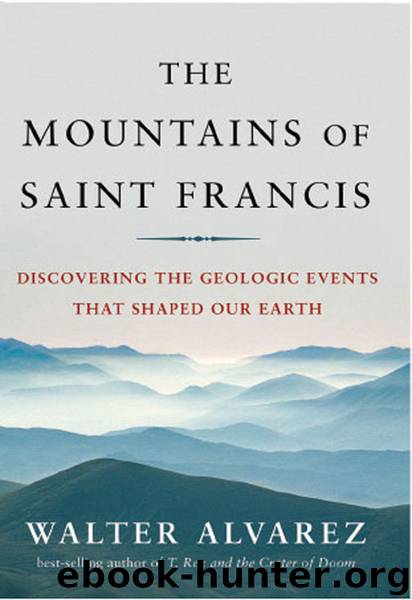The Mountains of Saint Francis by Walter Alvarez

Author:Walter Alvarez
Language: eng
Format: epub
Publisher: Amazon
Published: 2009-03-09T16:00:00+00:00
The approach of Adria, the Adriatic Promontory of African continental crust, toward the European continent, based on knowing the motions of Europe and Africa away from North America. When the two continents collided, Adria overrode Europe, and the Alps were the result. Geologists call this kind of ultrasimplified diagram a "cartoon." It focuses on the roll of Adria in Alpine deformation, omitting all the formidable complexities of the real geology.
The Broadest View of Mountain Tectonics
In our examination of the Alps we began by looking at the whole mountain belt as a great topographic barrier between Italy and the rest of Europe. Then we zoomed in on two details—the deep rocks exposed in the Italian Alps, and the thrust fault at Glarus. Finally we expanded our view still farther and recognized the whole mountain range of the Alps as the site of a collision between two great blocks of continental crust—Europe in the north, Italy and the rest of the Adriatic Promontory in the south.
Let us finish by tying this plate-tectonic view of the Alps to the topographic view we started with. How do colliding continents generate a mountain barrier? The answer is new and surprising, and offers a profound insight into how our planet evolves.39
If we view the Alps in the broadest perspective of distance and time, details like thrust faults fade into a blur of smooth, almost continuous deformation.40 In this view the Alps behave like a pile of sand on the beach, which can be squeezed, molded, and sculpted.
Think about what happens as Europe and Italy collide. Their continental crust is too buoyant to sink into the deep Earth, so as the collision continues, deformed crust must pile up higher and higher in the collision zone. When we realize that there have been many hundreds of kilometers of shortening in the collision, it is clear that the pile of deformed crust would get very high—far higher than the Alps are. What has happened to all that piled-up crust?
There are two ways that the pile is kept from growing ever higher. The first is by erosion, which attacks the growing mountains and carries them away, grain by grain. The higher the mountains, the more vigorous the erosion by rivers and glaciers. The second is by spreading out toward the sides, on the north and south. If you try to push sand on the beach into a pile that is too high, the pile will collapse outward. Gravity drives this collapse, and so we see the rebirth of gravity tectonics in a new form. Gravity carries the rising mountains away, thrust sheet by thrust sheet.
Geologists today are beginning to see the topographic barrier of the Alps as held in a delicate, constantly changing balance between the rise of continental rocks caught in the collision zone, their removal by erosion, and their outward collapse, driven by gravity. The balance is very sensitive, and even changes in rainfall can affect the evolution of a mountain range. There is evidence that wetter periods
Download
This site does not store any files on its server. We only index and link to content provided by other sites. Please contact the content providers to delete copyright contents if any and email us, we'll remove relevant links or contents immediately.
Man-made Catastrophes and Risk Information Concealment by Dmitry Chernov & Didier Sornette(5951)
The Revenge of Geography: What the Map Tells Us About Coming Conflicts and the Battle Against Fate by Kaplan Robert D(4052)
Zero Waste Home by Bea Johnson(3804)
COSMOS by Carl Sagan(3584)
Good by S. Walden(3515)
In a Sunburned Country by Bill Bryson(3504)
The Fate of Rome: Climate, Disease, and the End of an Empire (The Princeton History of the Ancient World) by Kyle Harper(3030)
A Wilder Time by William E. Glassley(2833)
Camino Island by John Grisham(2778)
Organic Mushroom Farming and Mycoremediation by Tradd Cotter(2660)
The Ogre by Doug Scott(2656)
Human Dynamics Research in Smart and Connected Communities by Shih-Lung Shaw & Daniel Sui(2479)
Energy Myths and Realities by Vaclav Smil(2461)
The Traveler's Gift by Andy Andrews(2432)
9781803241661-PYTHON FOR ARCGIS PRO by Unknown(2341)
Inside the Middle East by Avi Melamed(2324)
Birds of New Guinea by Pratt Thane K.; Beehler Bruce M.; Anderton John C(2235)
A History of Warfare by John Keegan(2210)
And the Band Played On by Randy Shilts(2163)
